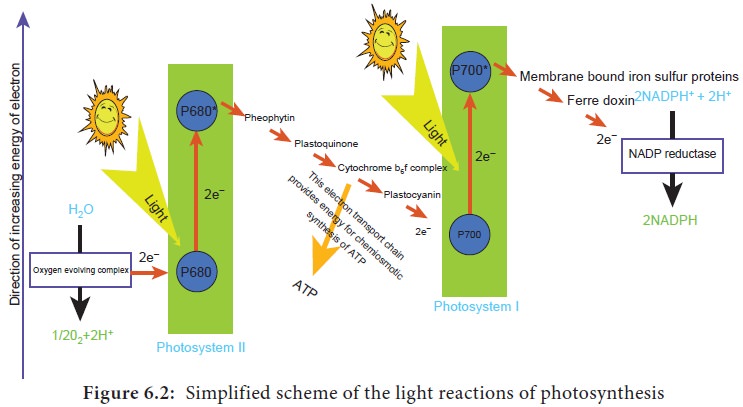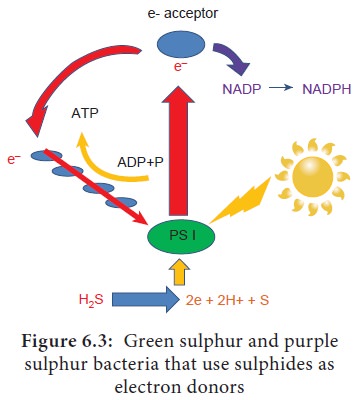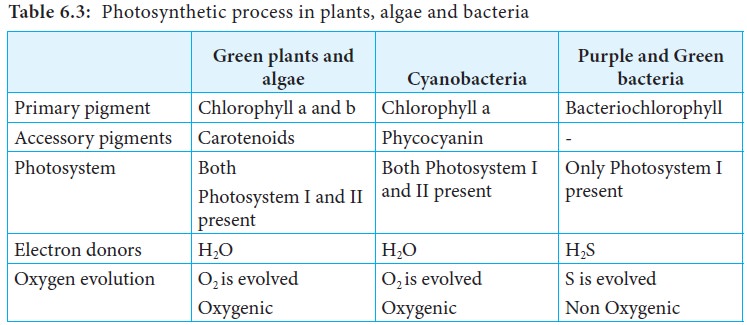Microbial Nutrition and Growth - Photosynthesis | 11th Microbiology : Chapter 6 : Microbial Nutrition and Growth
Chapter: 11th Microbiology : Chapter 6 : Microbial Nutrition and Growth
Photosynthesis
Photosynthesis
Photosynthesis is a process of capturing light energy and converting
into chemical energy. The chemical energy produced in the form of ATP and NADPH
is used to synthesise organic compounds (carbohydrates); to be used as food.
This ability makes photosynthesis, a significant process taking place on earth.
Eukaryotes (plants and algae) and prokaryotes (cyanobacteria and
purple, green bacteria) are capable of carrying out photosynthesis.
Cyanobacteria perform photosynthesis in a similar manner to plants.
Process of photosynthesis in cyanobacteria
The process of Photosynthesis is divided into
1.
Light reaction
2.
Dark reaction
In light reaction, light energy is captured by photosynthetic
pigments and converted into chemical energy (ATP and NADPH).
In dark reaction, the chemical energy is used to fix CO2
to construct organic compounds (carbohydrates); to be used as food. This
reaction is also called CO2 fixation or Calvin’scycle.
Light reactions in cyanobacteria
• Photosynthetic pigments
All photosynthetic organisms contain pigments to observe light.
Chlorophyll is the main pigment involved in the absorption of light. In
cyanobacteria, chlorophyll a is the
predominant pigment present and it absorbs red light at a wavelength of 665nm.
Cyanobacteria also contain accessory pigments like phycobiliprotein
(Phycoerythrin and phycocyanin) which help to absorb light at a broader
wavelength (470-630nm) and makes photosynthesis more efficient. These pigments
are located in the cytoplasmic membrane of cyanobacteria.
Photosystems
The pigment molecules are arranged in highly organized arrays
called reaction center or Photosystems. Cyanobacteria and green plants have two
photosystems namely Photosystem I (P700) and Photosystem II (P680) through
which the electrons, excited by the capture of photons, flow.
When P700 (Photosystem I) absorbs energy and gets excited, the
excited electron is transferred through a series of proteins like ferrodoxins
and are eventually used to reduce NADP+ to produce NADPH+.
(When a compound accepts electrons, it is said to be reduced). When P680
absorbs light and gets excited, the electron passes through pheophytin,
plastaquinone, cytochromes and plastacyanin to be donated to the oxidised P700
in order to replenish the lost electron. It is during this process, ATP
(Adenosine Tri phosphate) is generated (Figure 6.2). Oxidised P680 obtains
electron when water is split (Photolysis) into oxygen atoms (1/2 O2)
and hydrogen ions (2H+) which results in evolution of oxygen. Hence
it is called oxygenic photosynthesis.

This process of electron flow where two photosystems are
involved in the generation of ATP is called non cyclic photophosphorylation.

Photosynthesis in Bacteria
There are four groups of photosynthetic bacteria. They are green
sulphur bacteria (Example: Chlorobium)
and green non sulphur bacteria (Example: Chloroflexus)
purple sulphur bacteria (Example: Chromatium)
and purple non sulphur bacteria
(Example: Rhodospirillum). These
photosynthetic bacteria can fix atmospheric CO2 in a similar fashion
like cyanobacteria but using only one photosystem and using H2S as
the electron donor instead of H2O.
Process of photosynthesis in bacteria
The electron transport system in purple and green bacteria
consists of only one Photosystem PSI (P870). They do not possess photosystem
II. When P870 gets excited upon capture of light energy, it donates the
electron to bacteriopheophytin. Electrons flow through quinones and cytochromes
and are reverted back to P870. This process is cyclic (since the electron

A
reversed electron flow operates in purple bacteria to reduce NAD+ to
NADH. Electrons are extracted from external electron donors like hydrogen
sulphide, hydrogen, elemental sulphur and organic compounds to synthesise NADH.
Since H2O is not used as electron donor, oxygen is not evolved which
explains the anoxygenic nature of the organisms involved (Figure 6.3). The
sulphur evolved during this reaction is deposited as sulphur globules either
outside or inside the cells. CO2 + H2S → (CH2O)n + S. Table 6.3
compares the photosystheic process in plants, algae and bacteria.

Related Topics